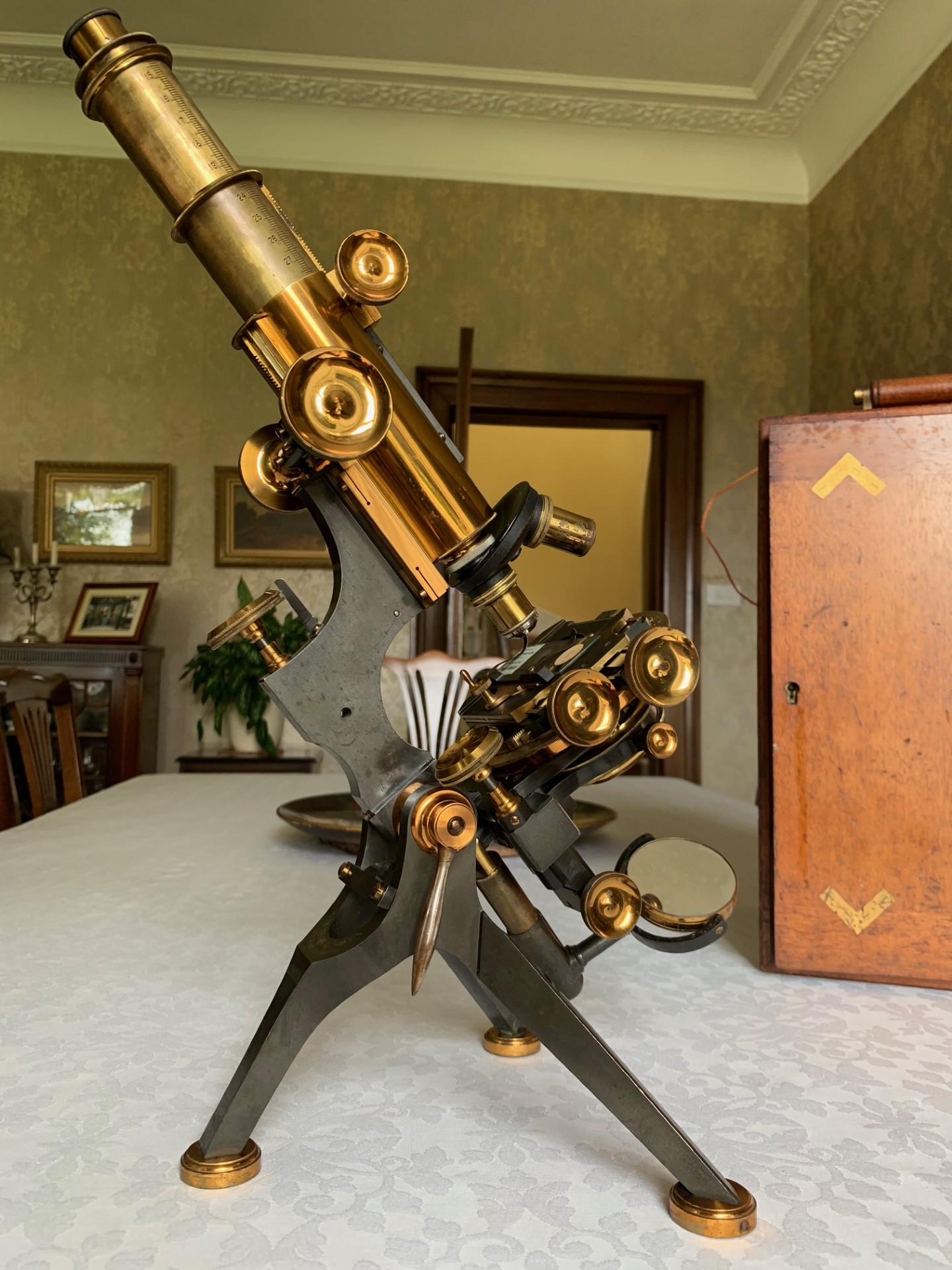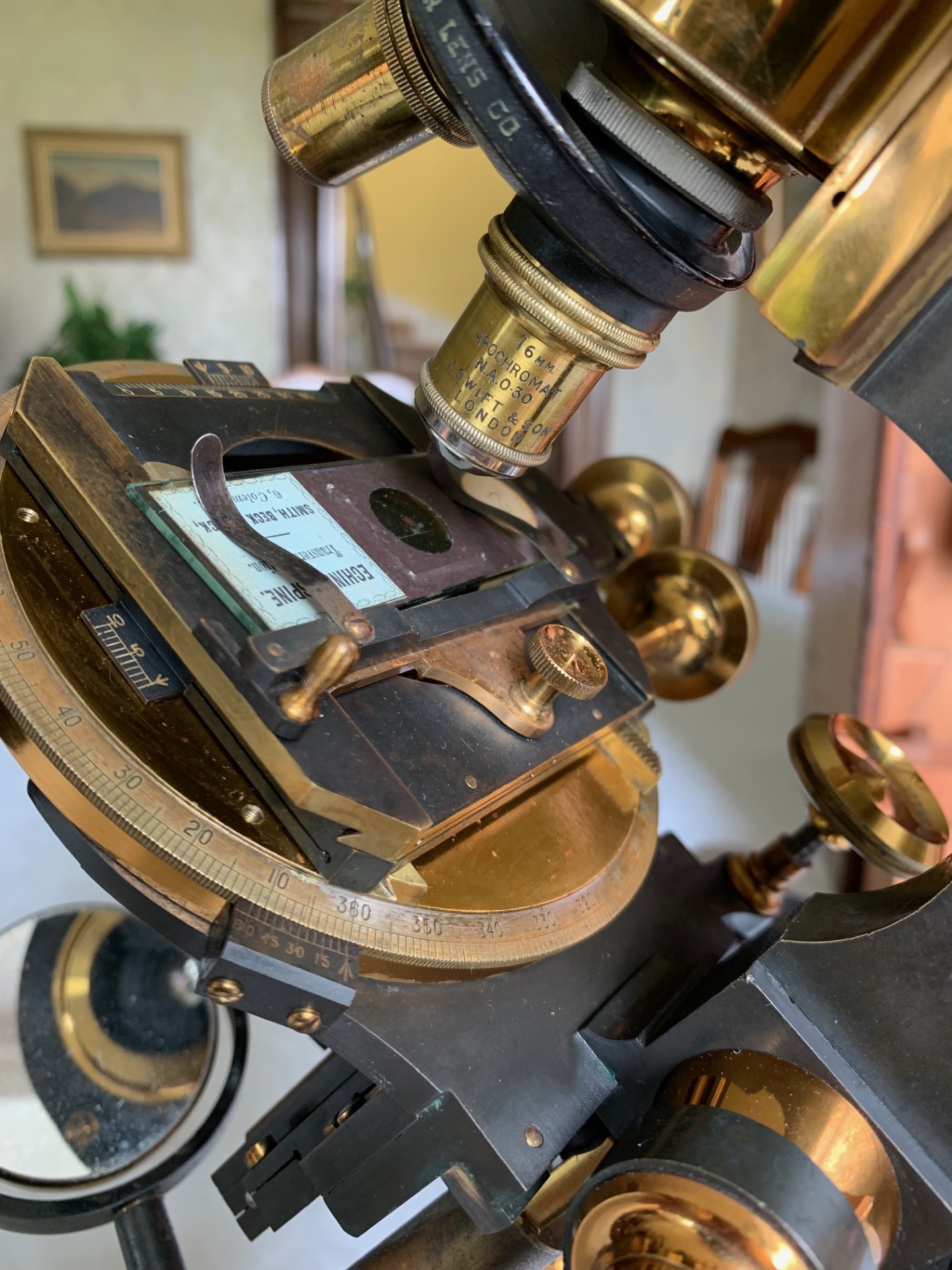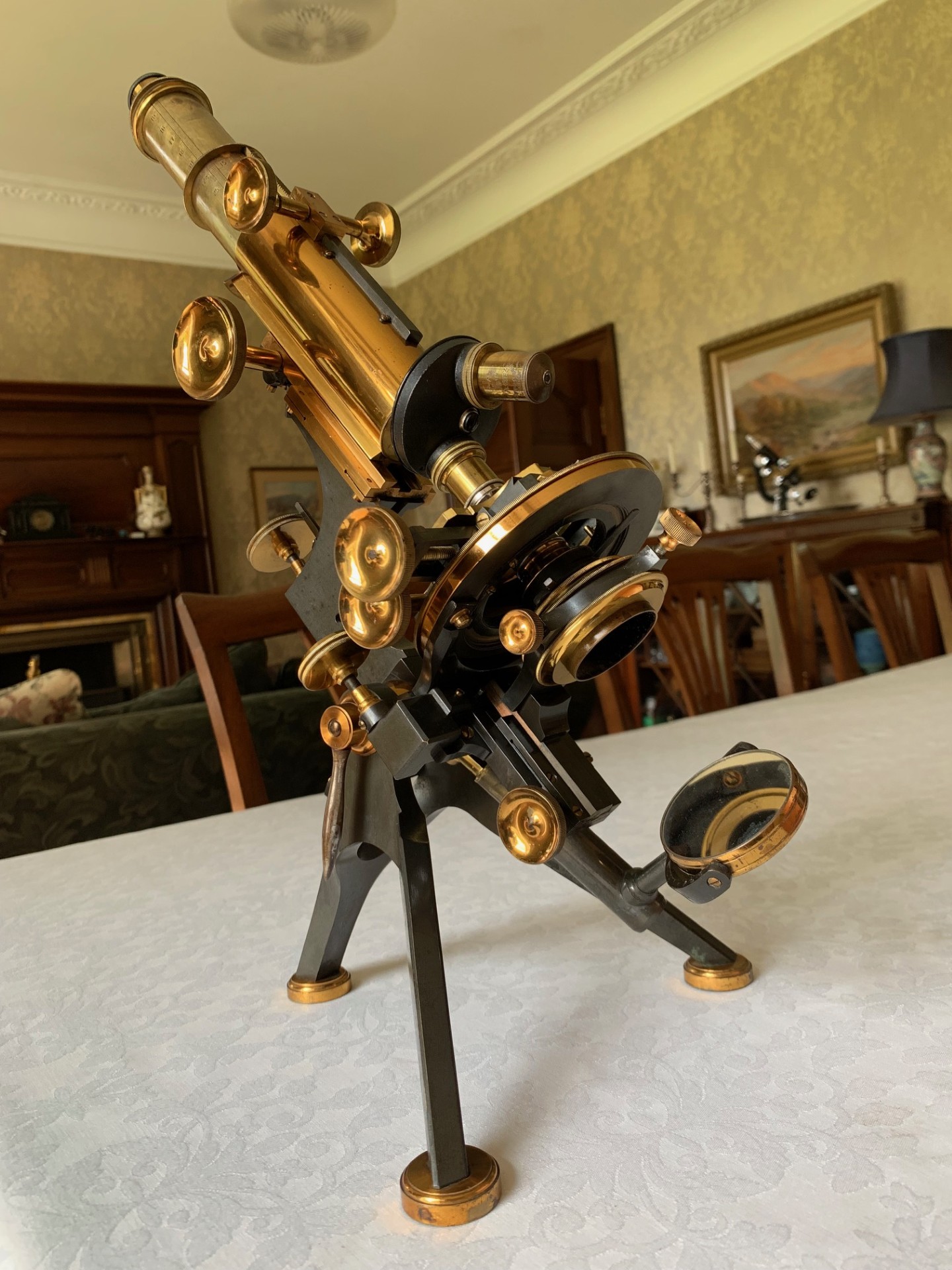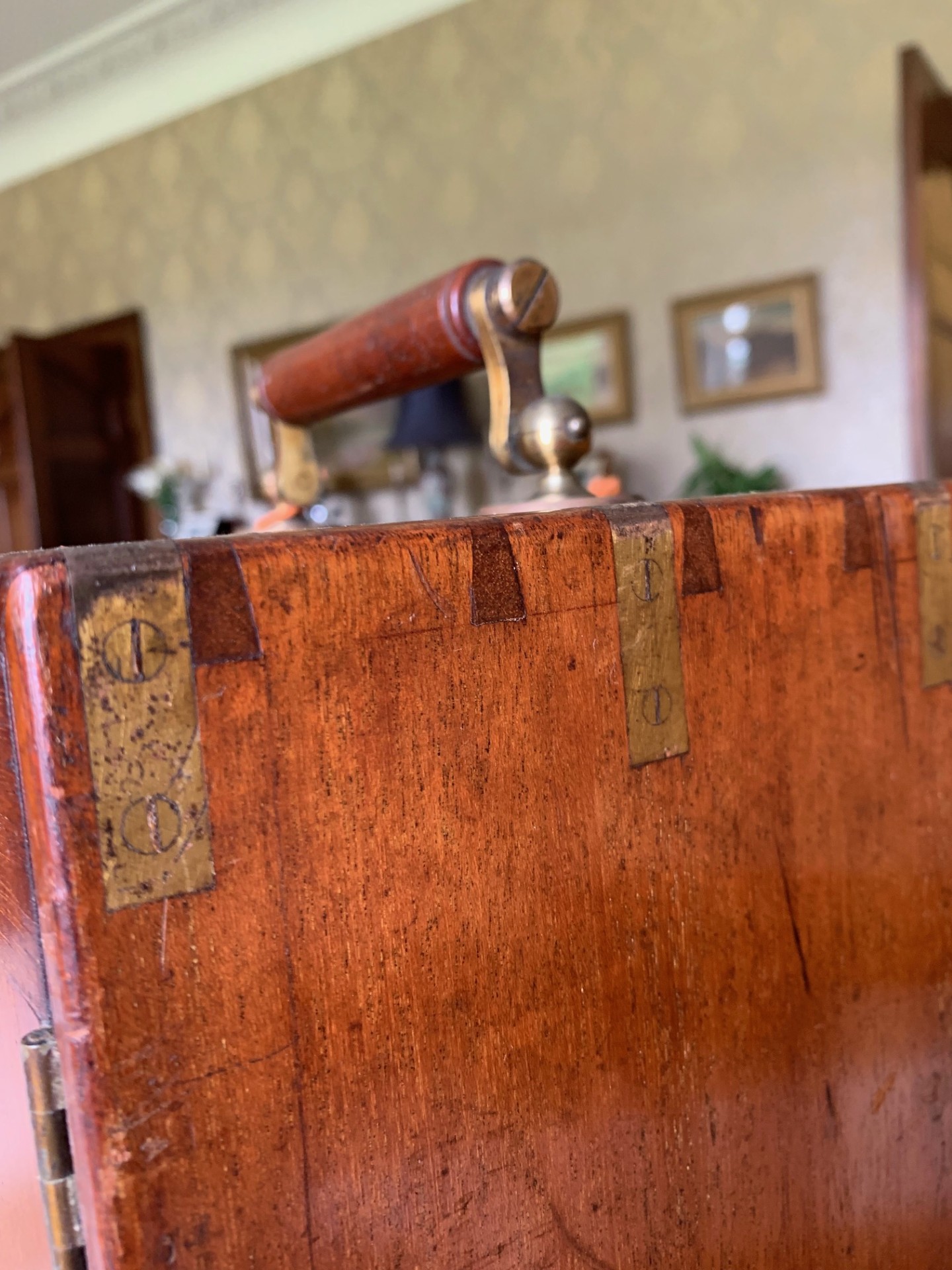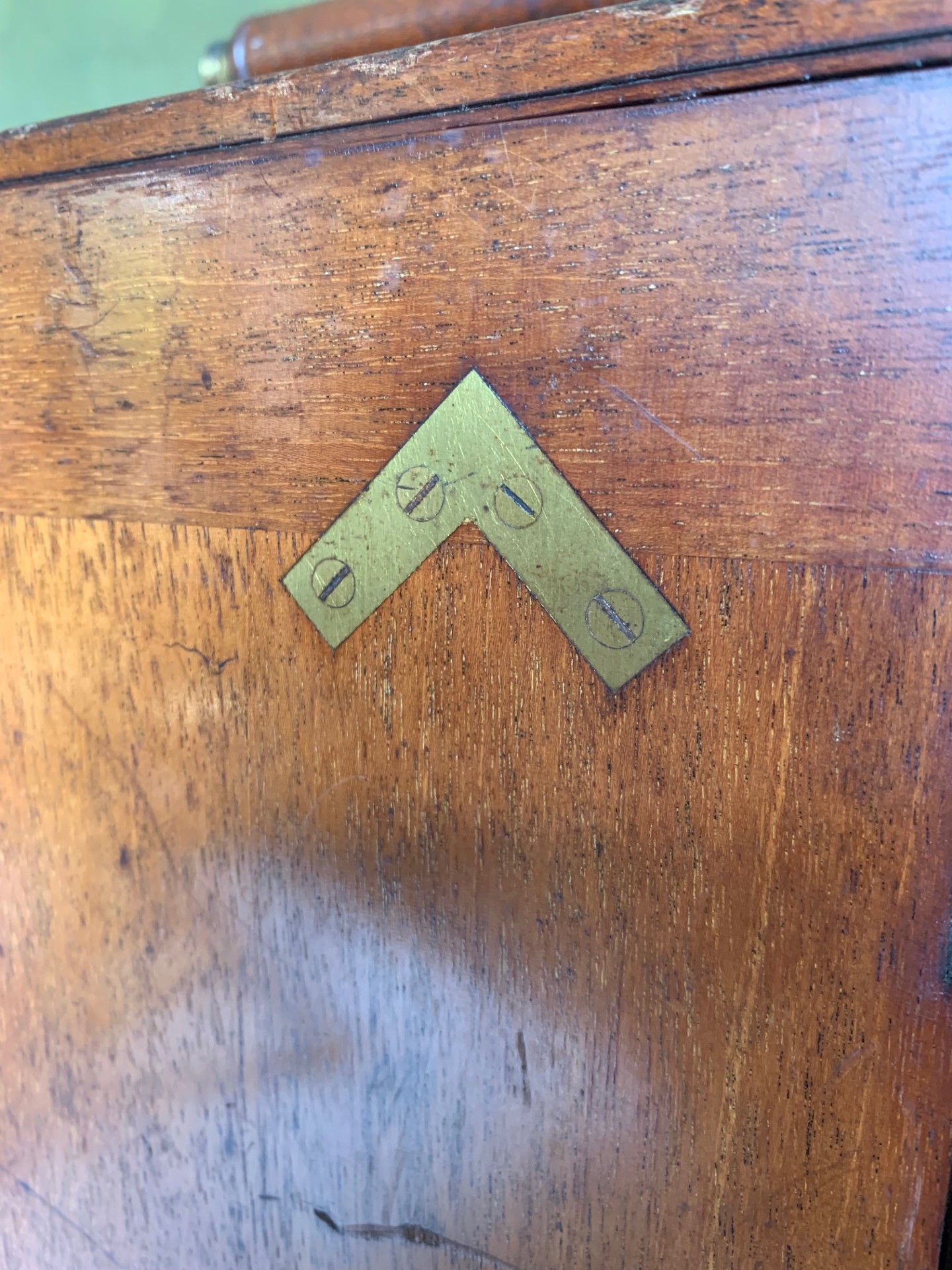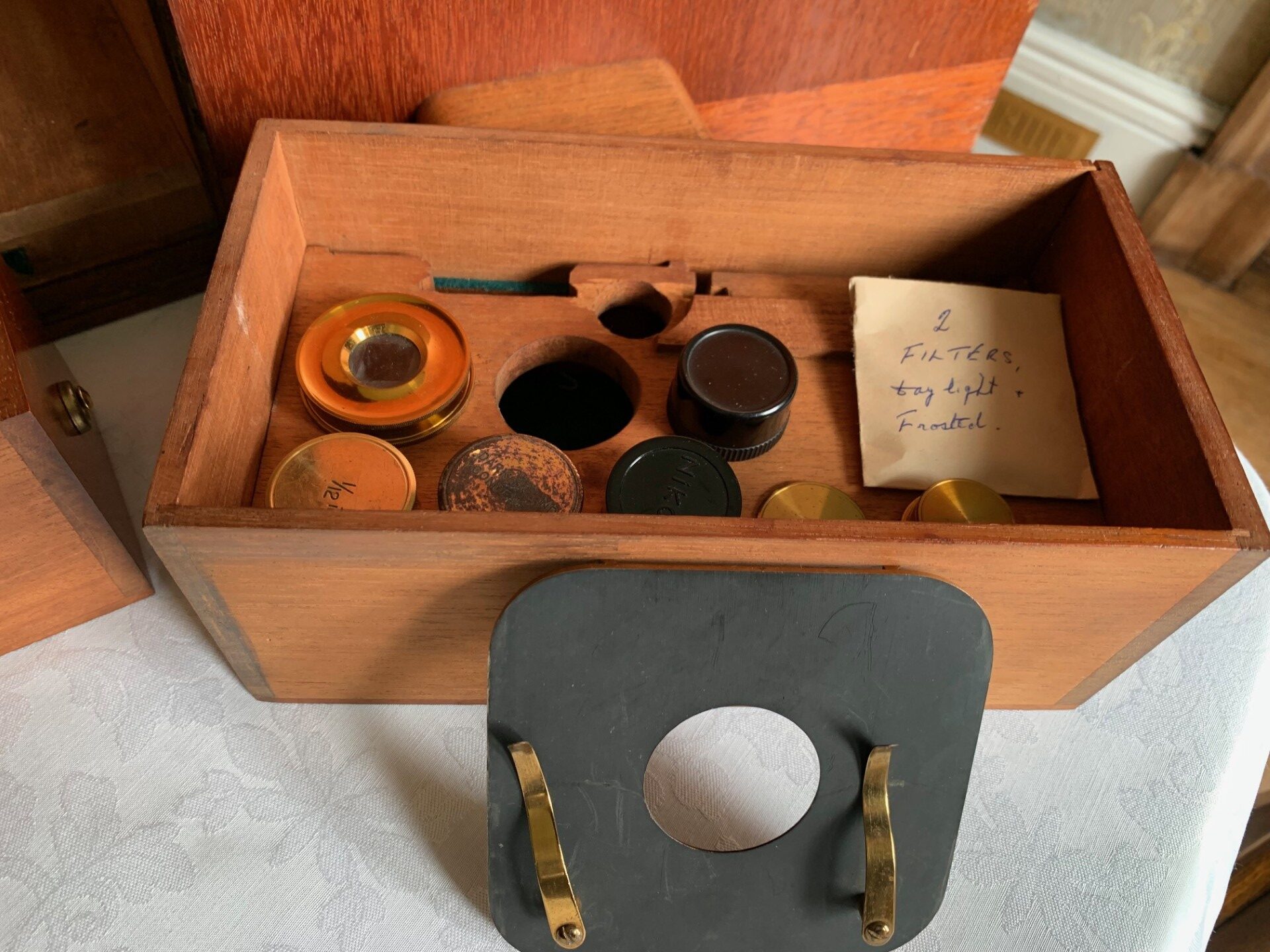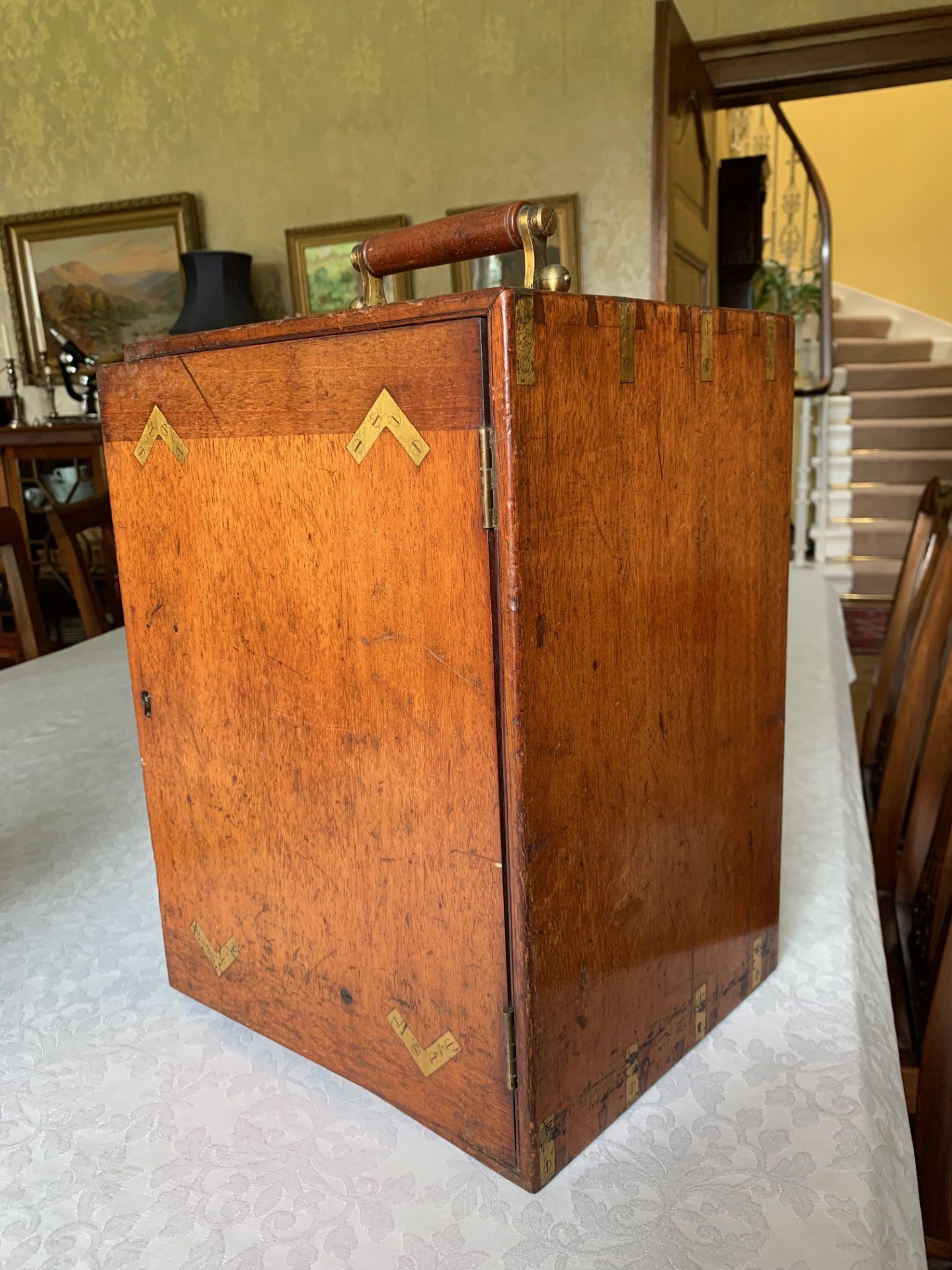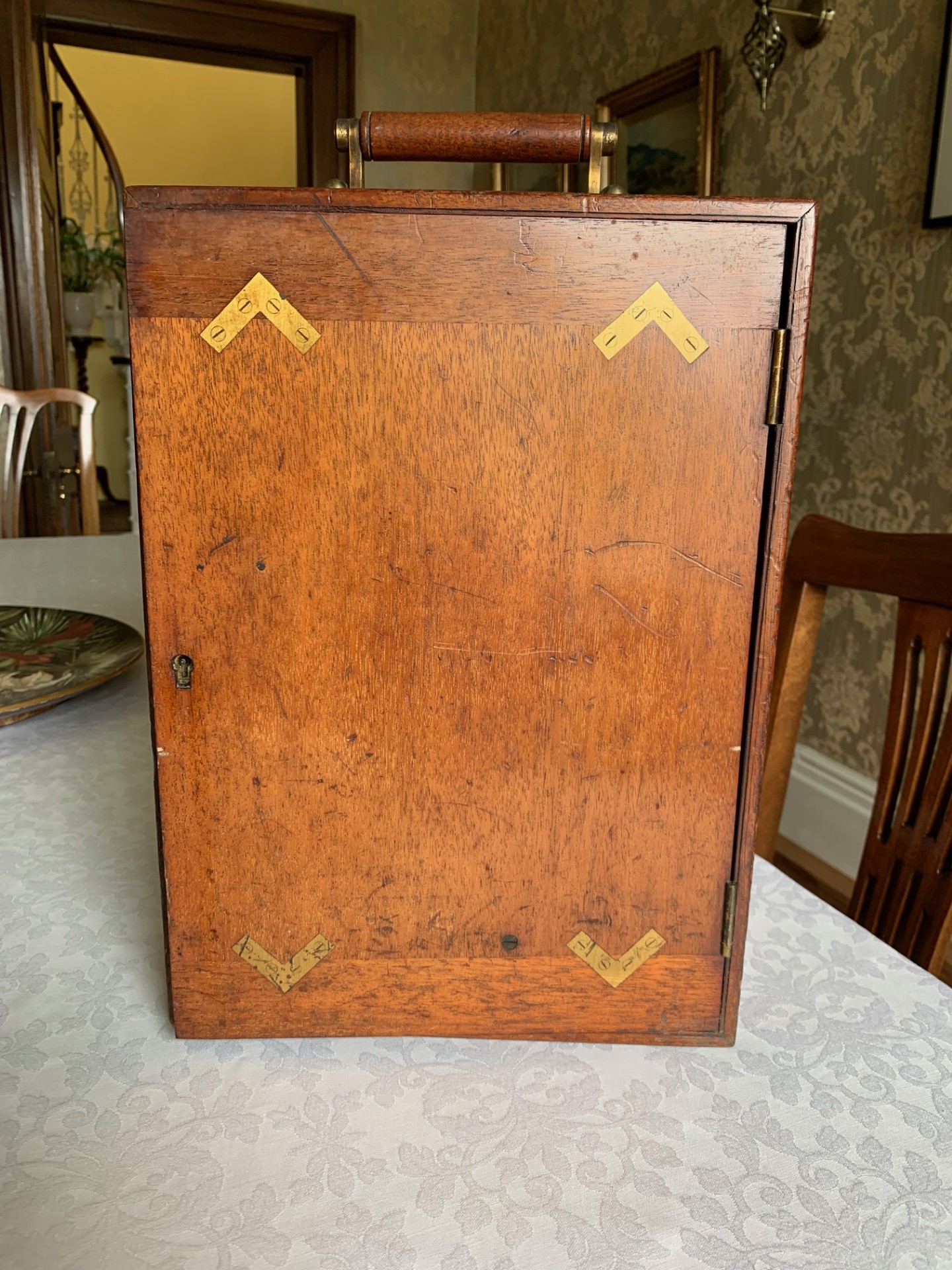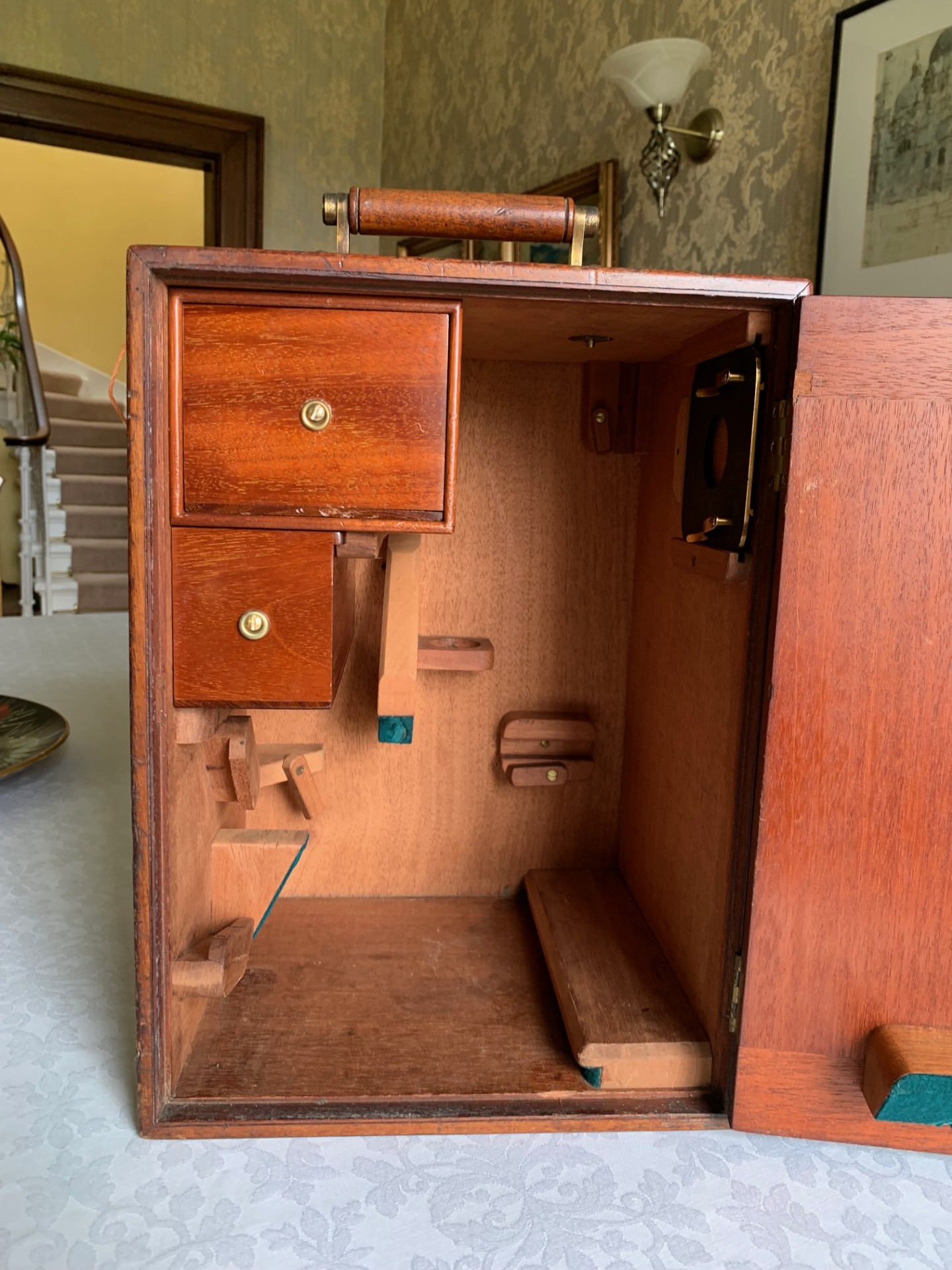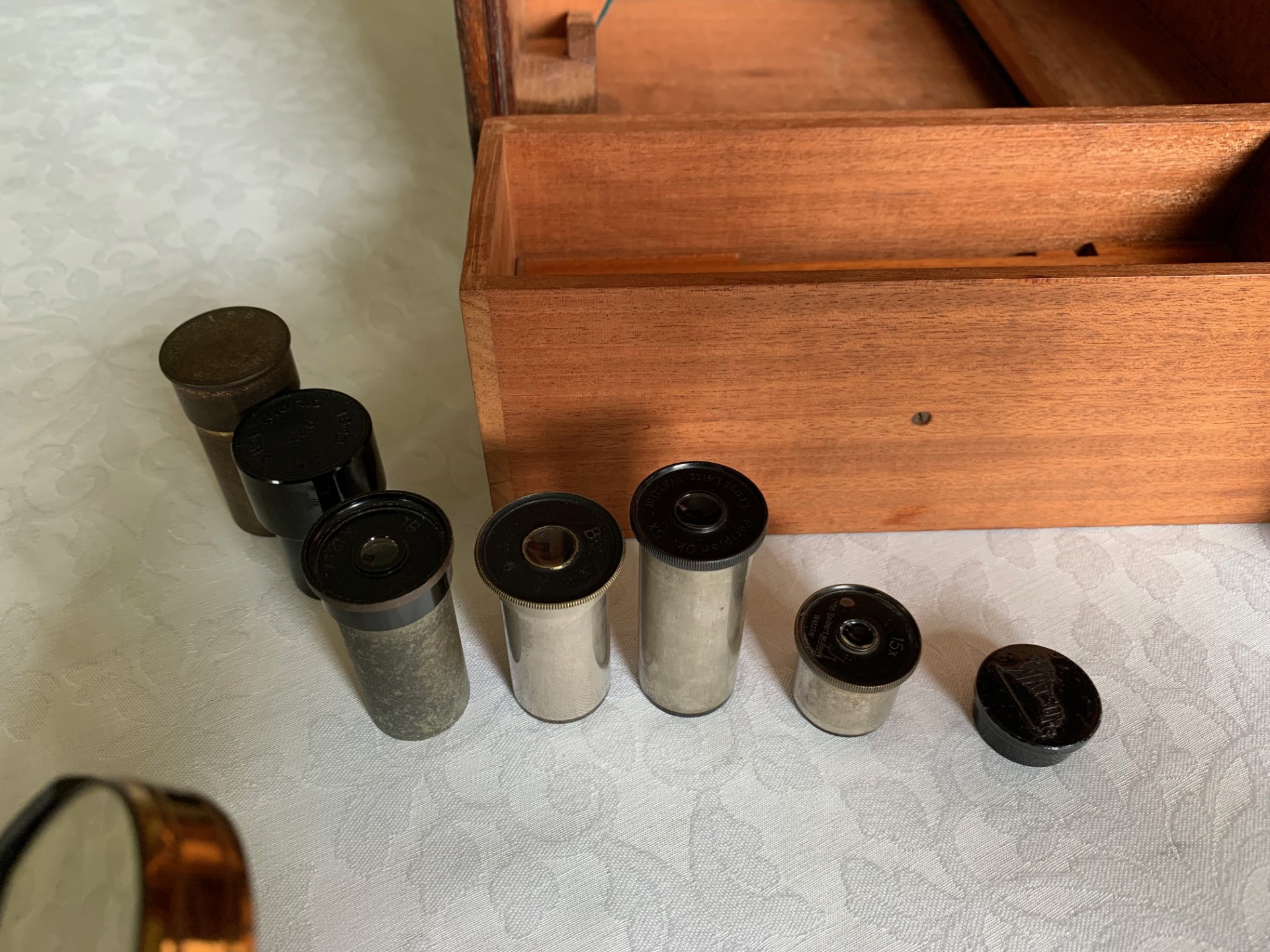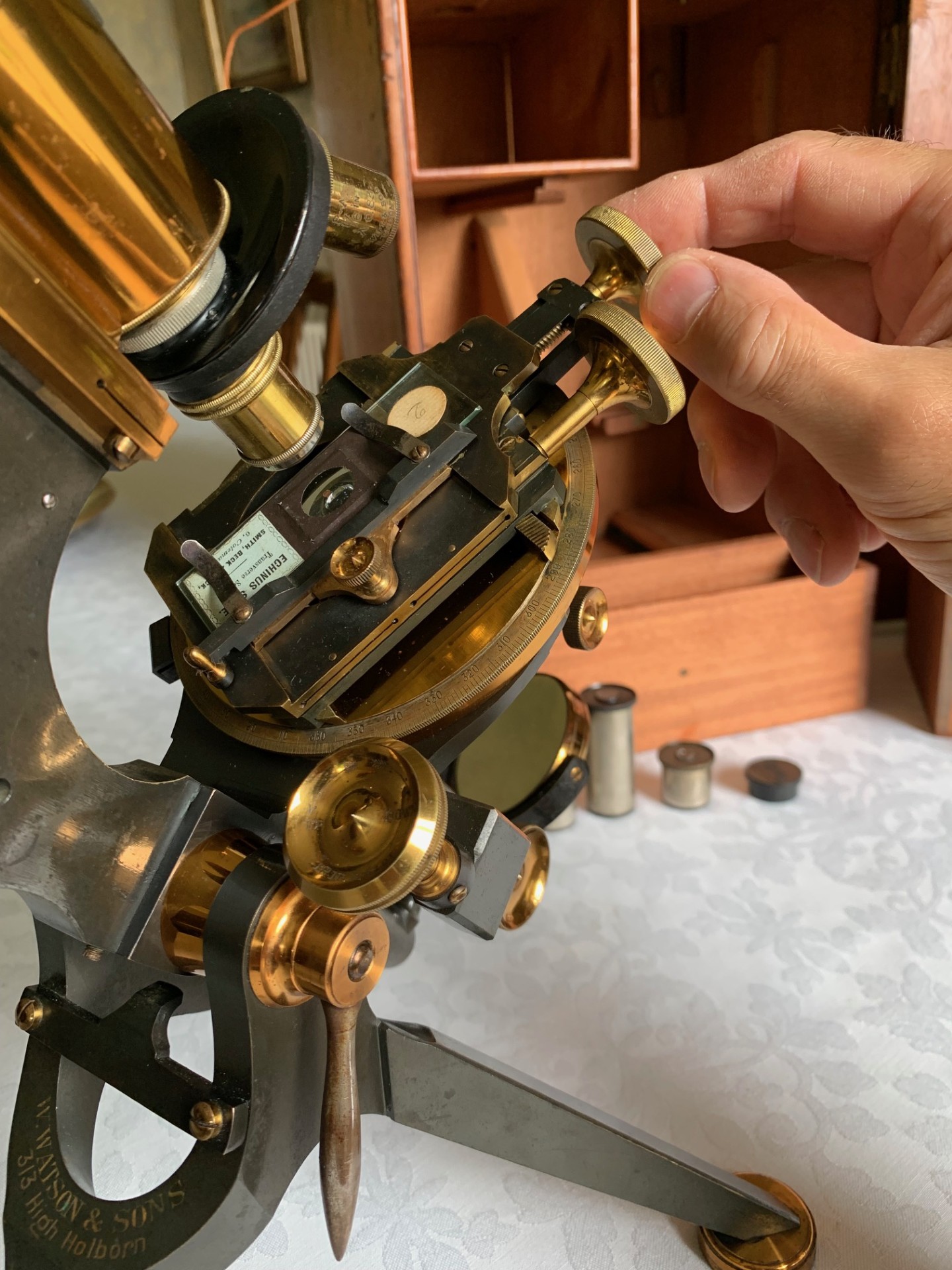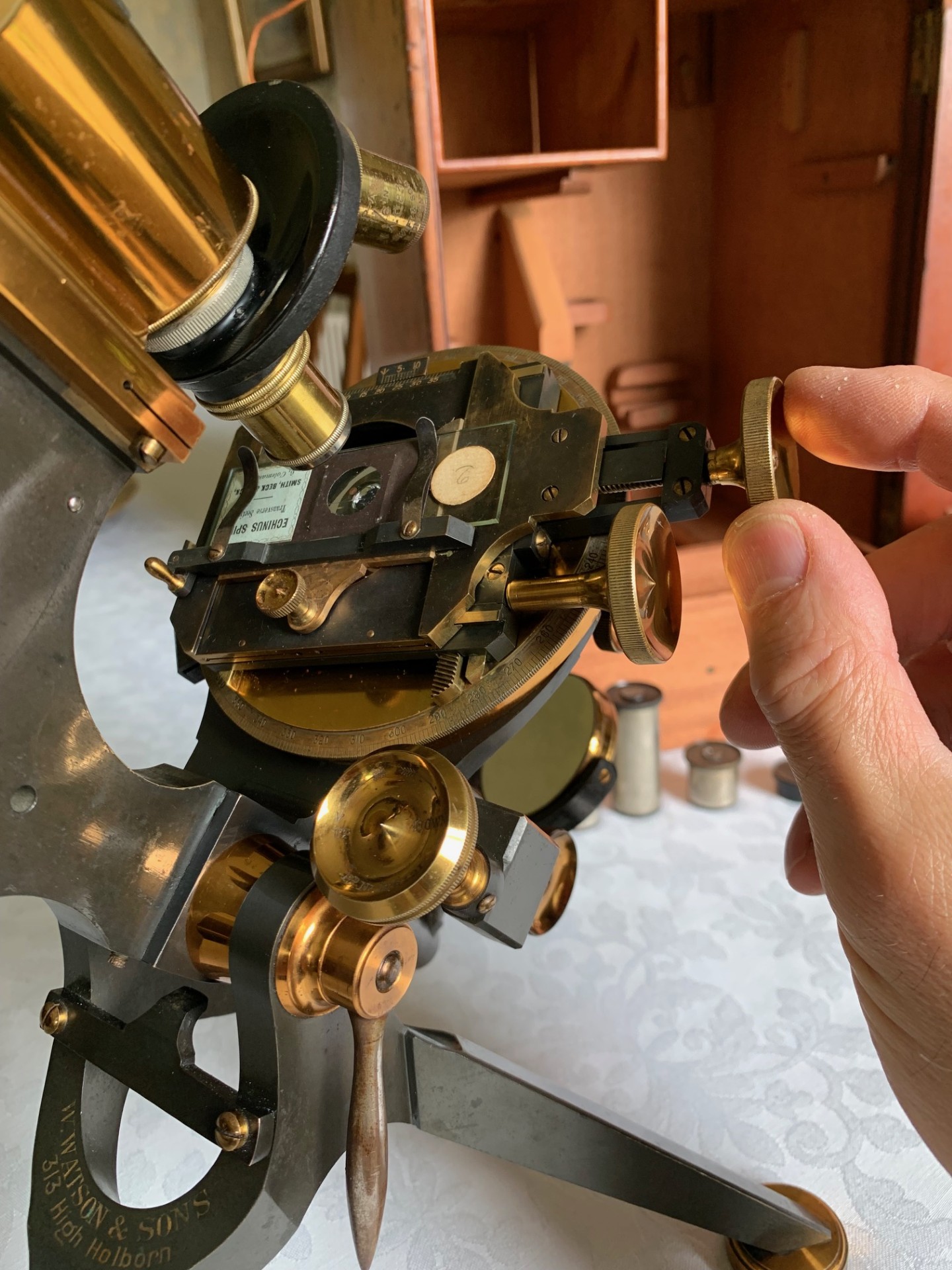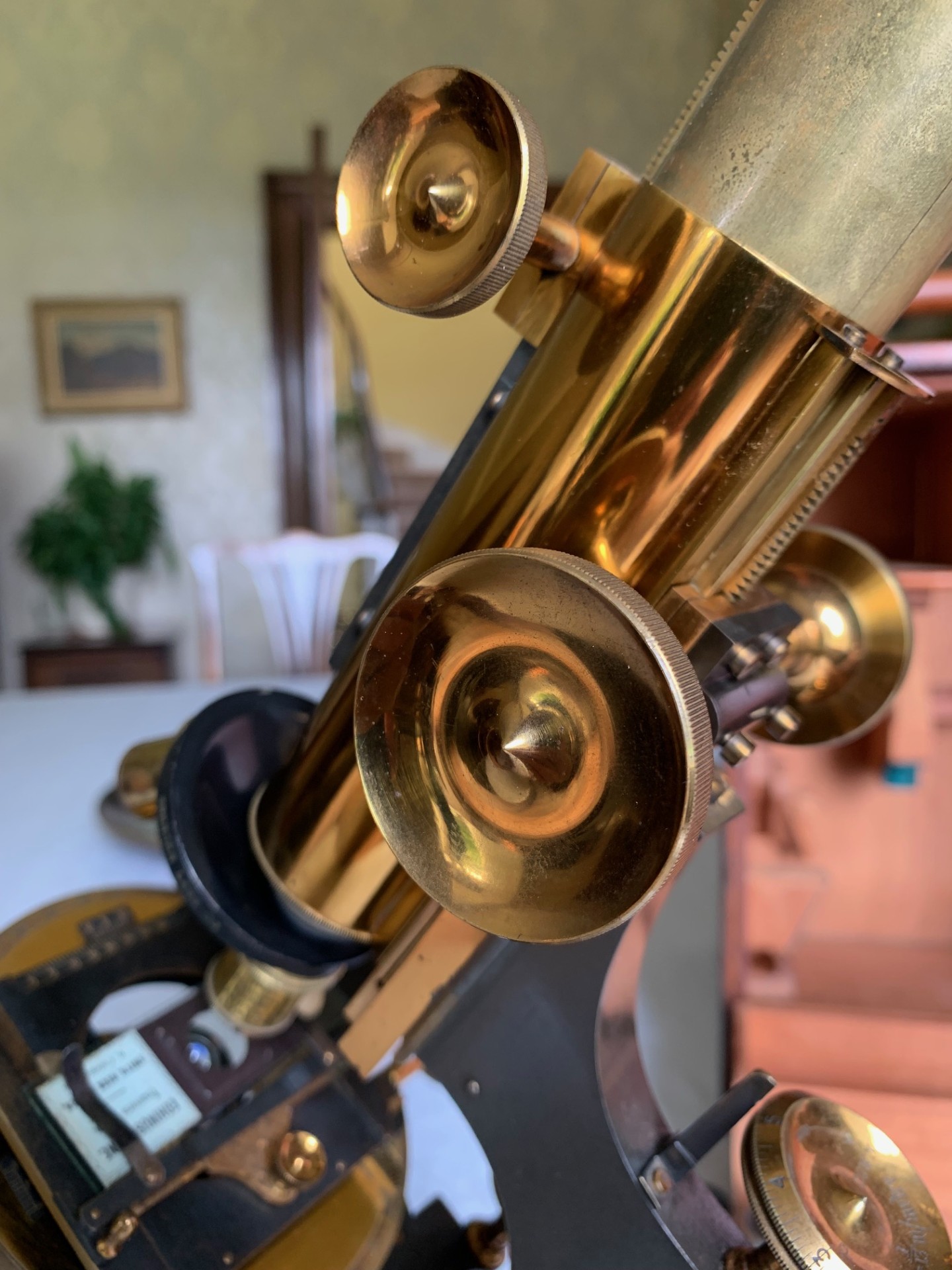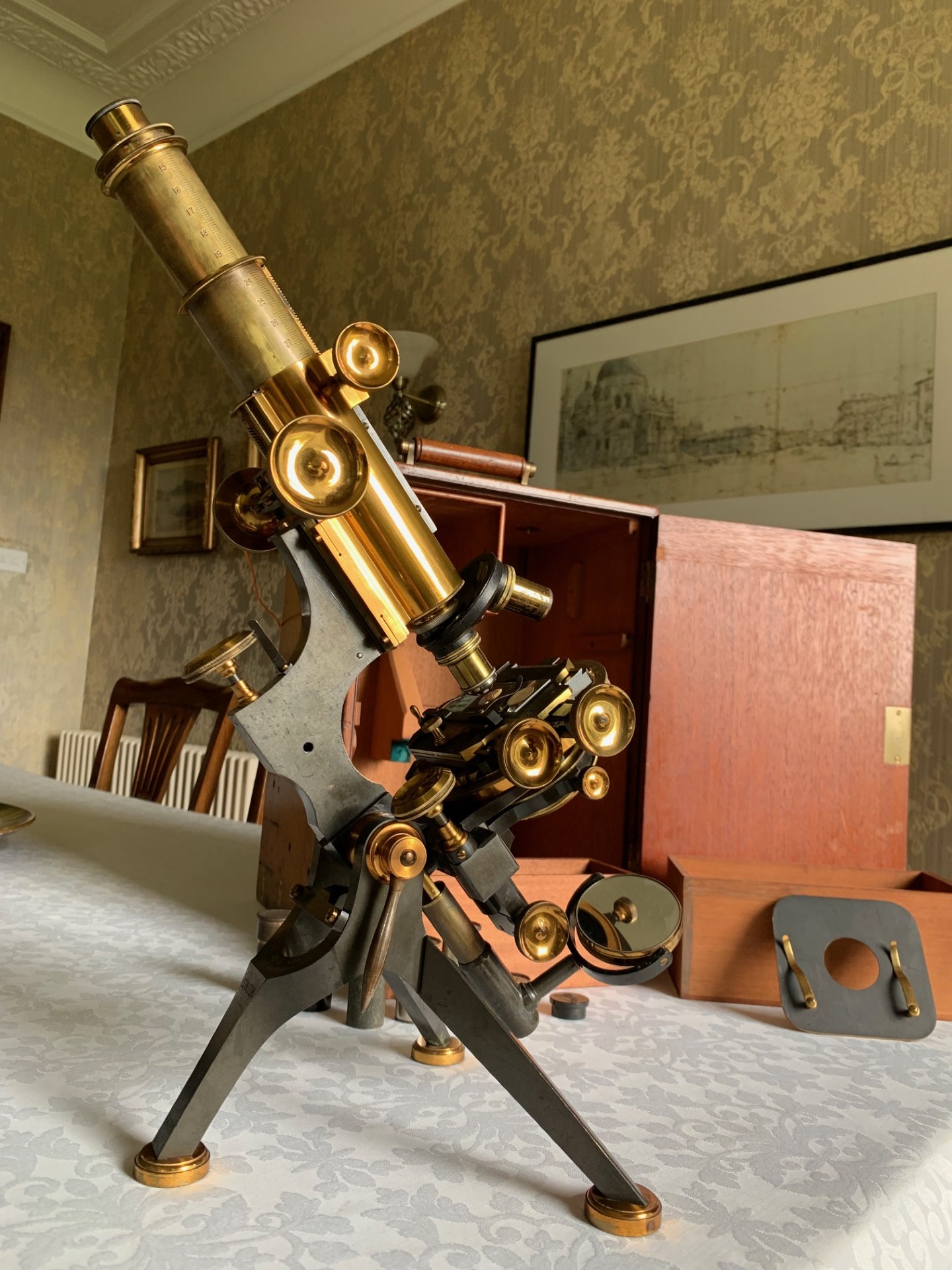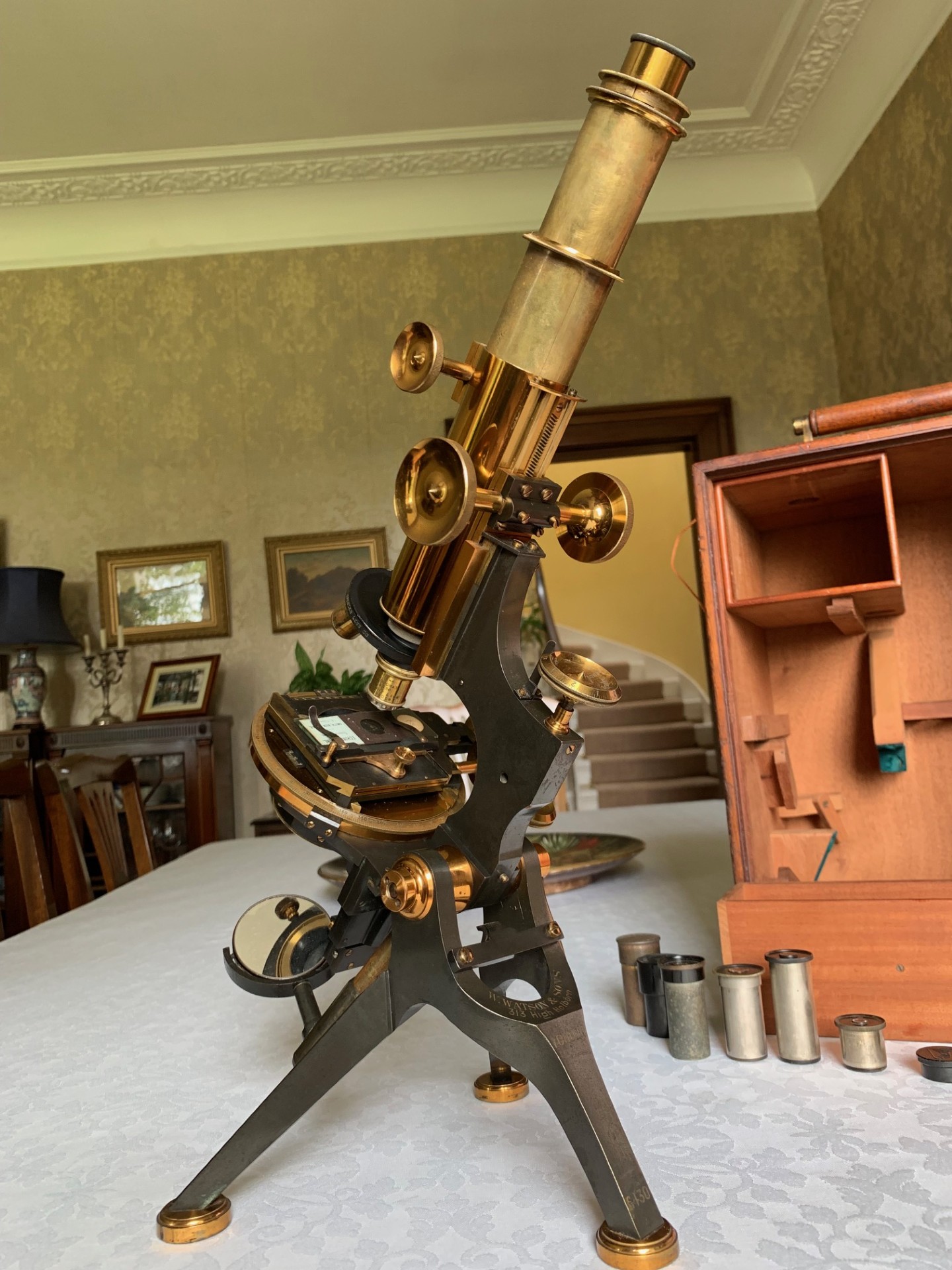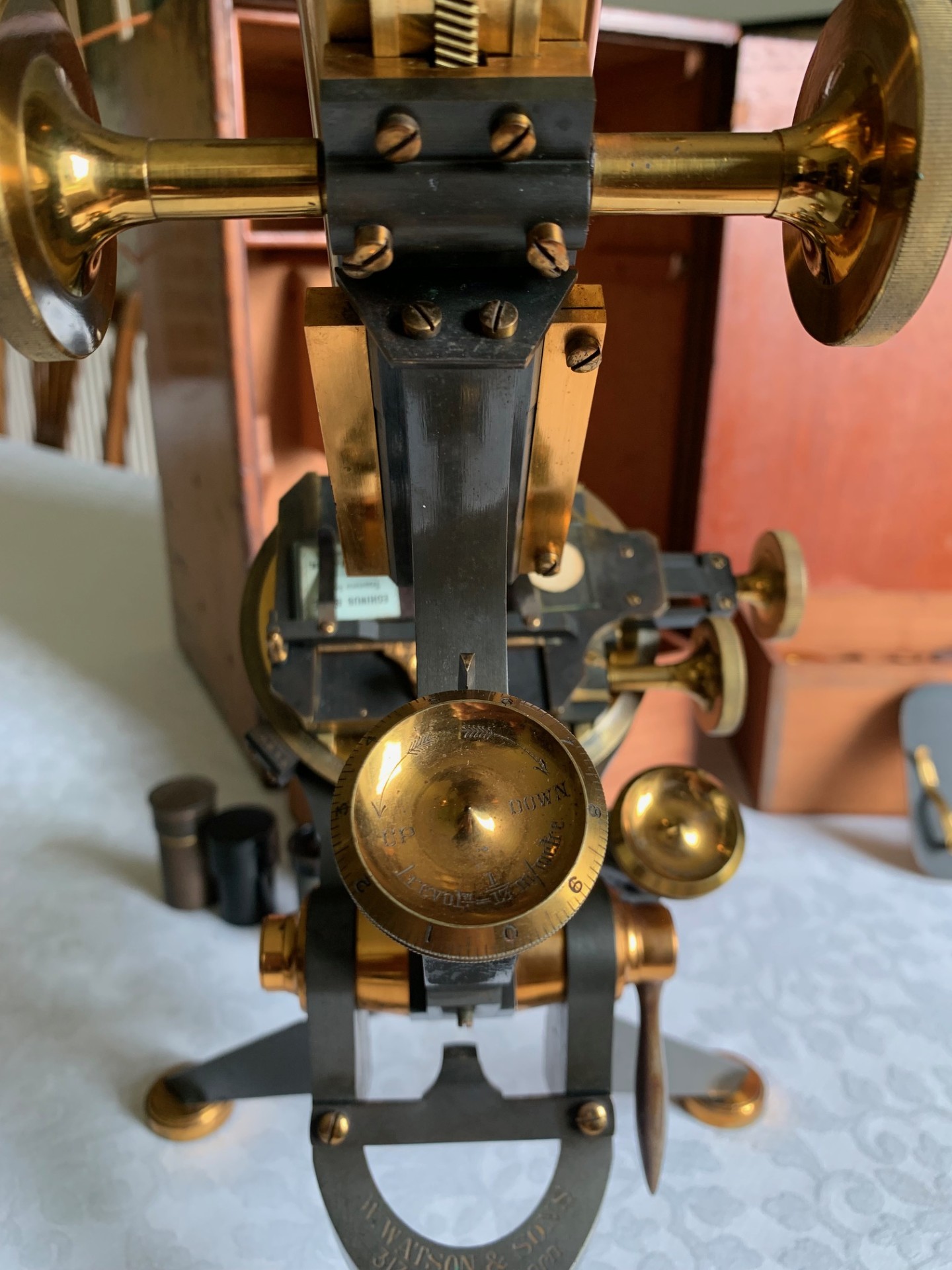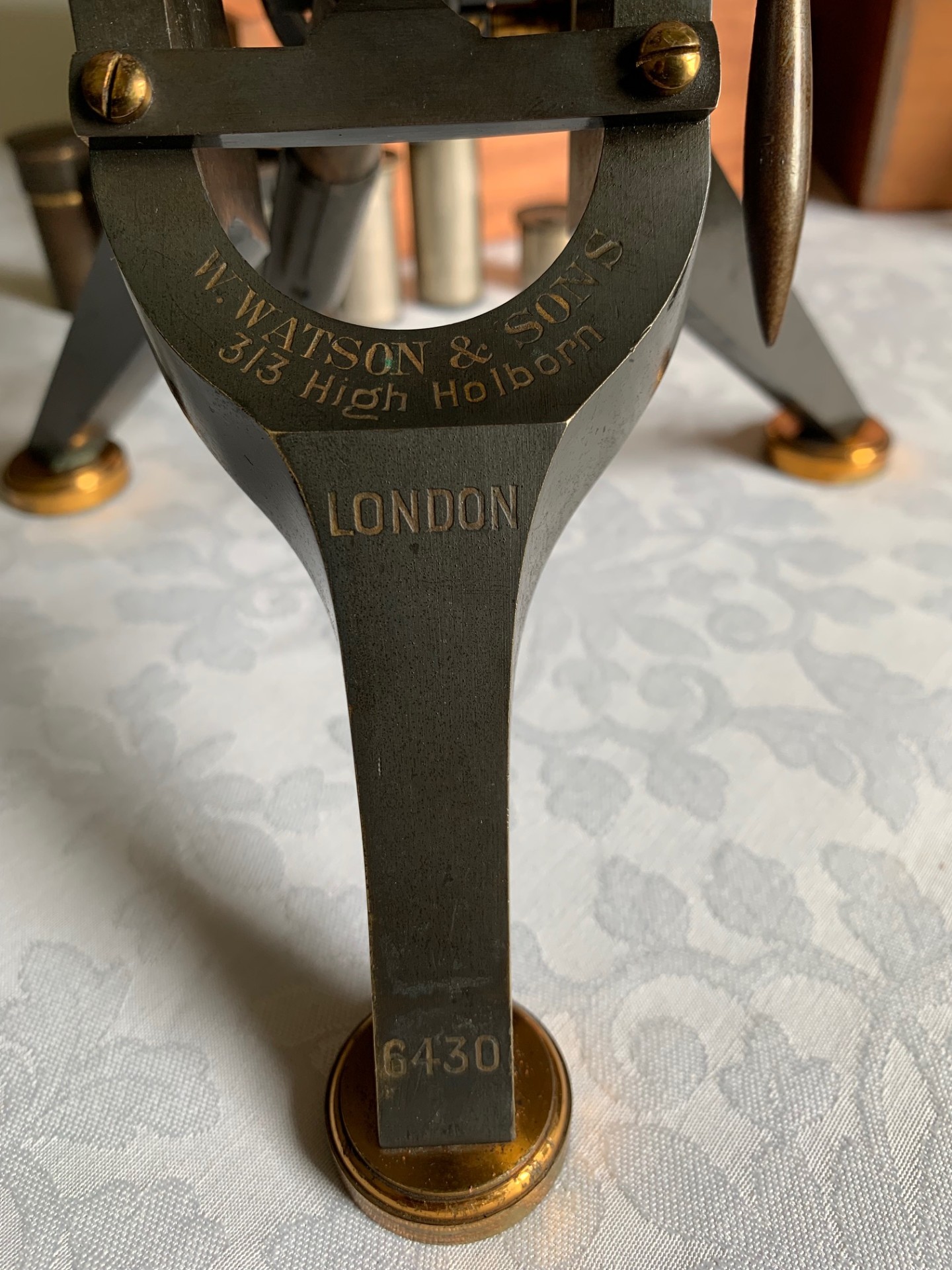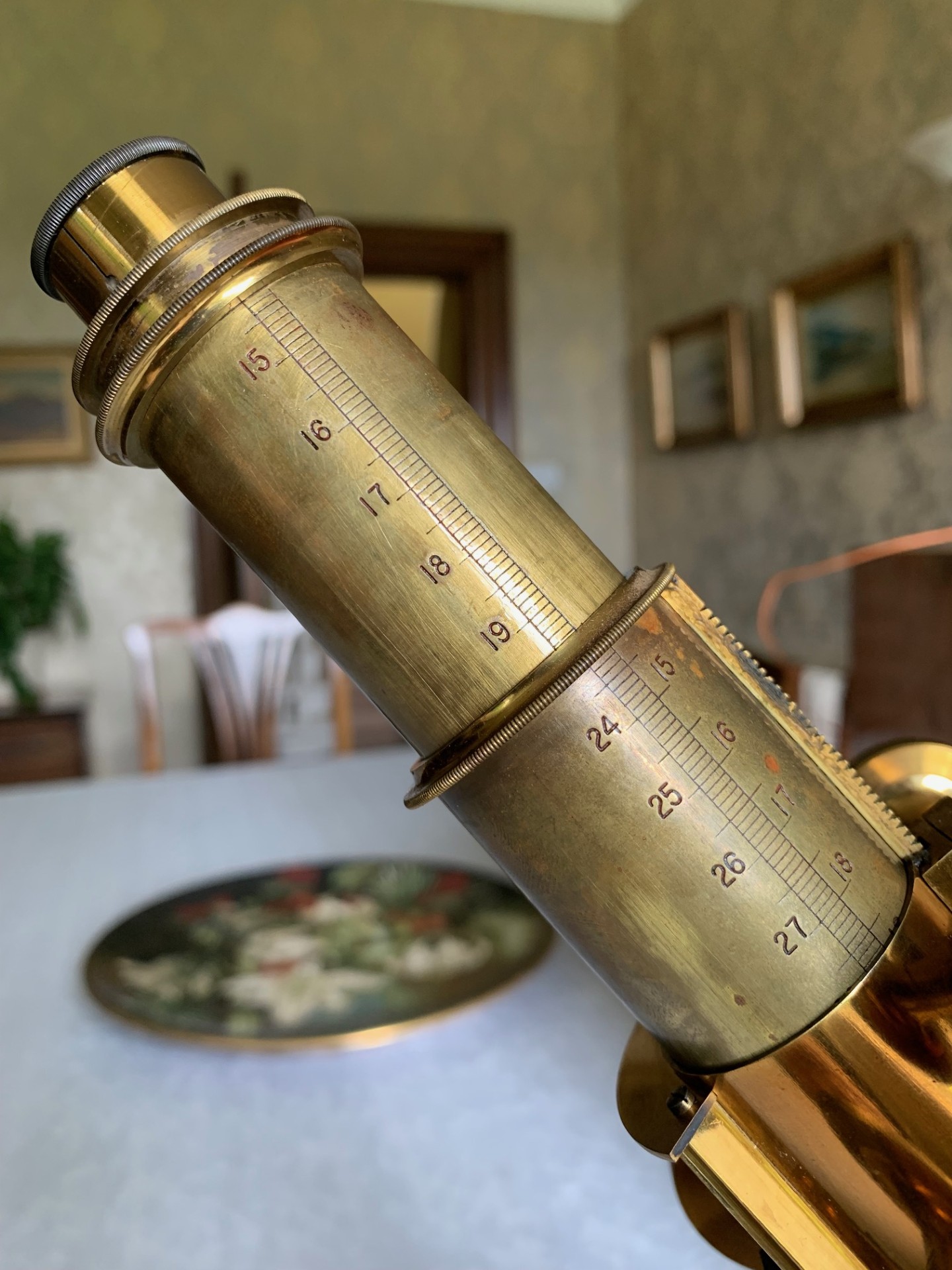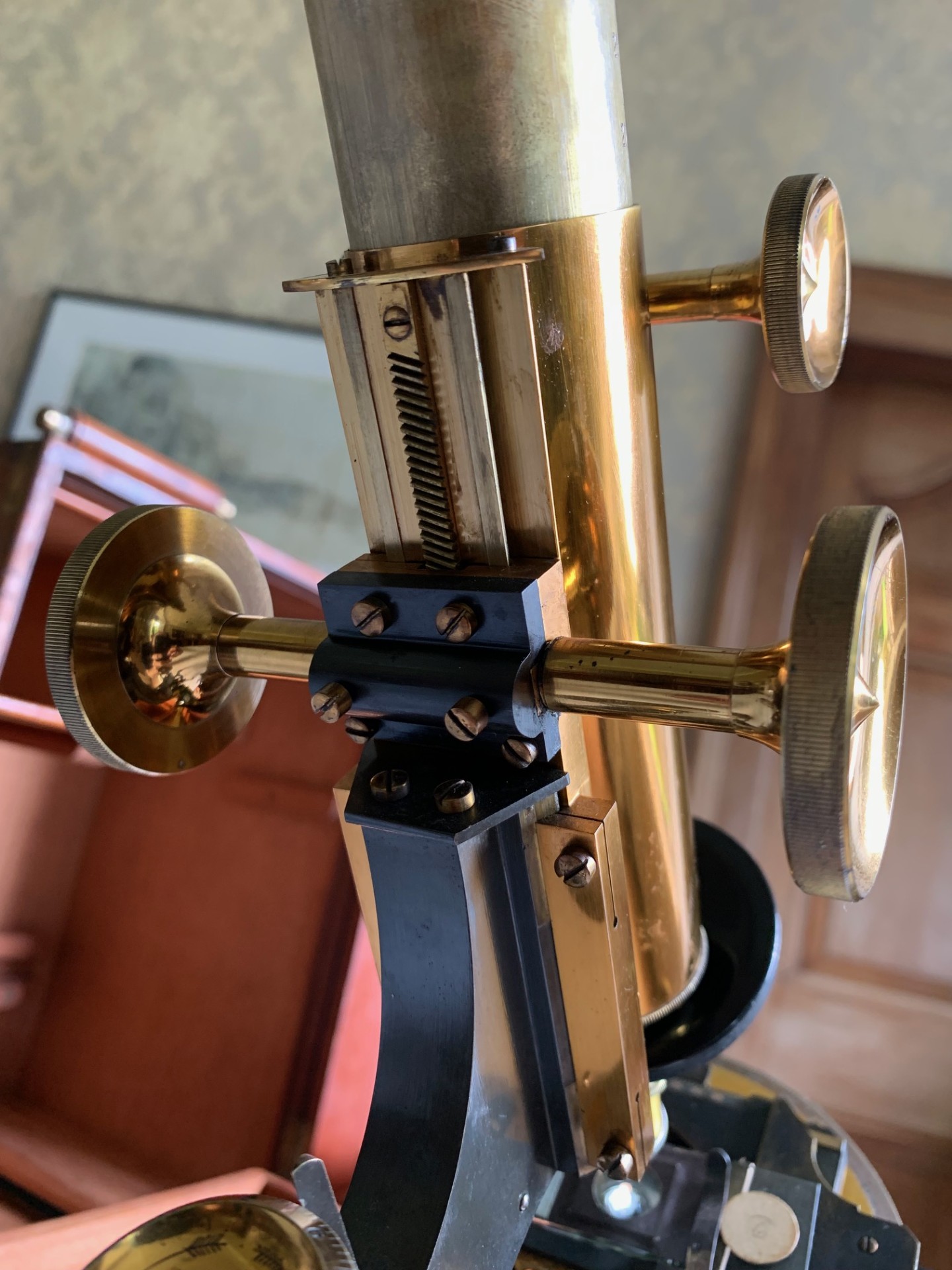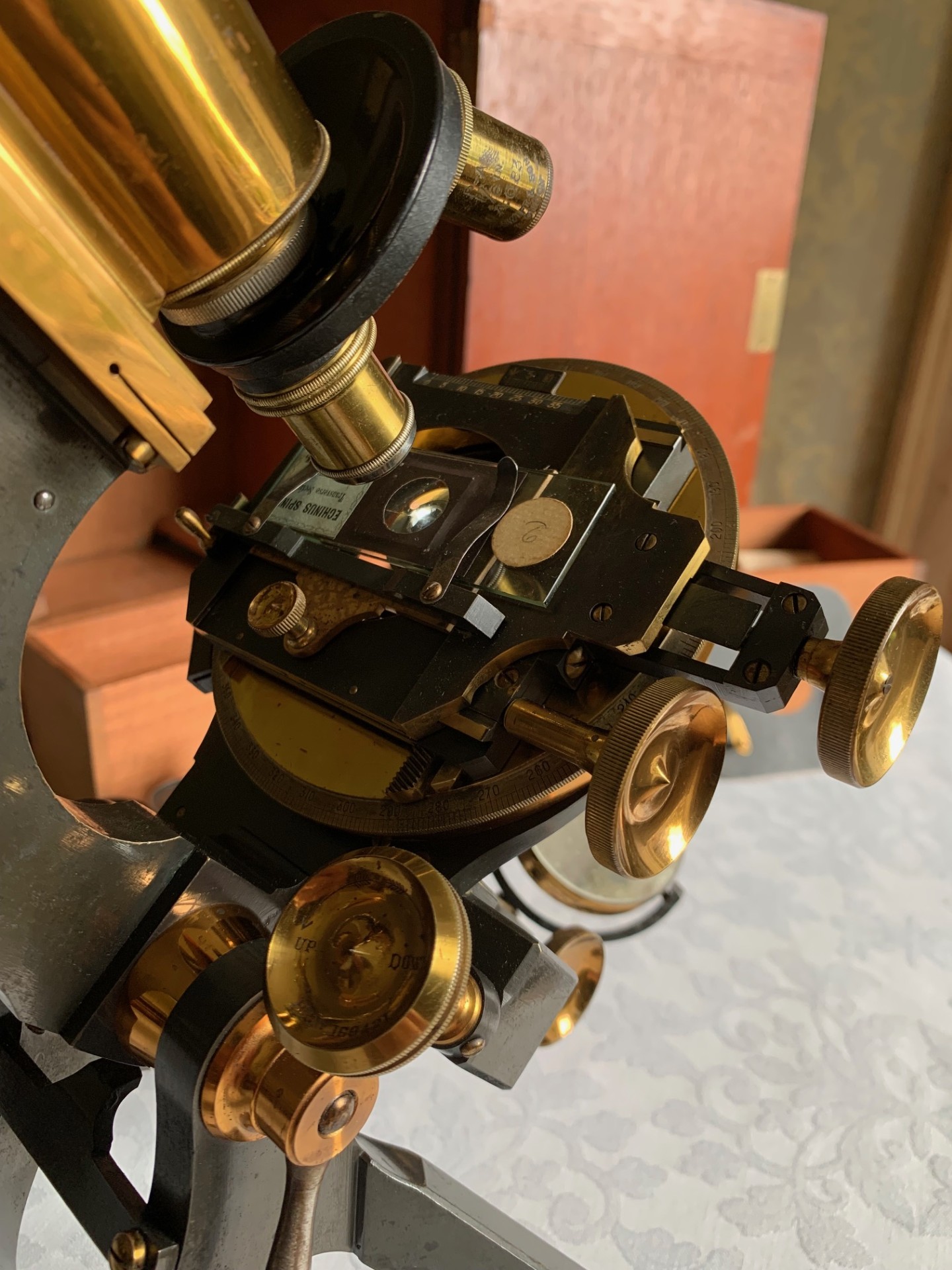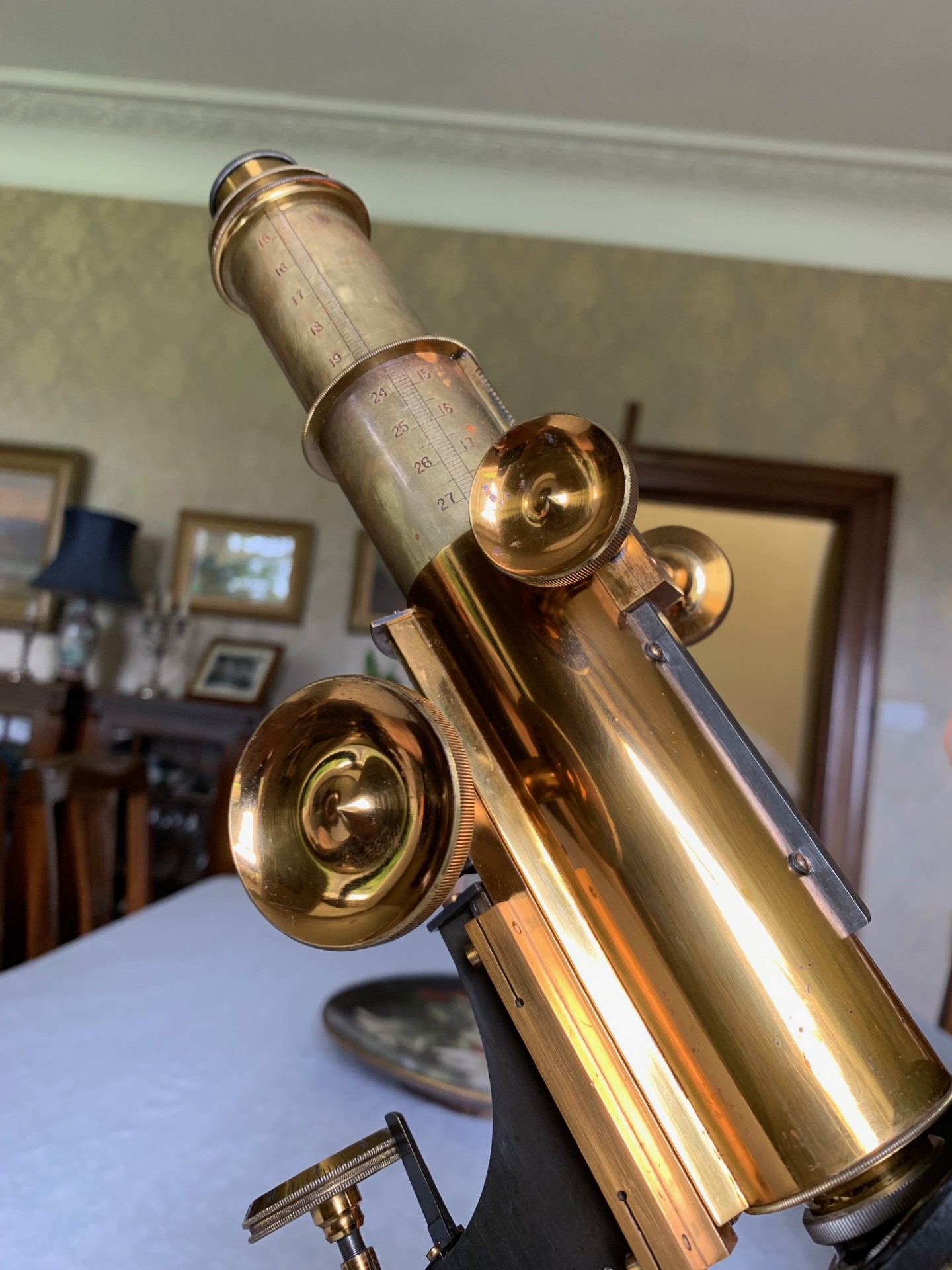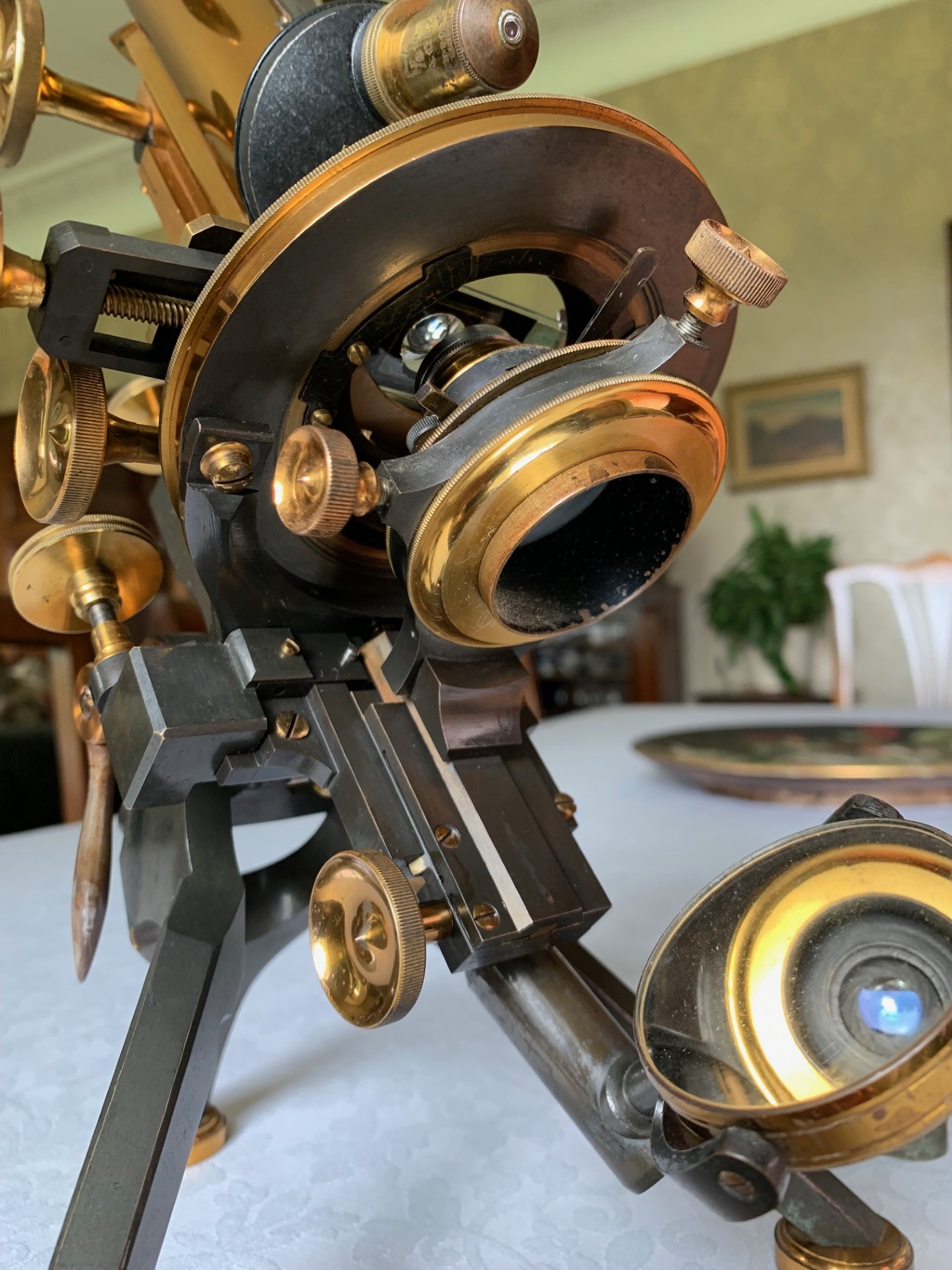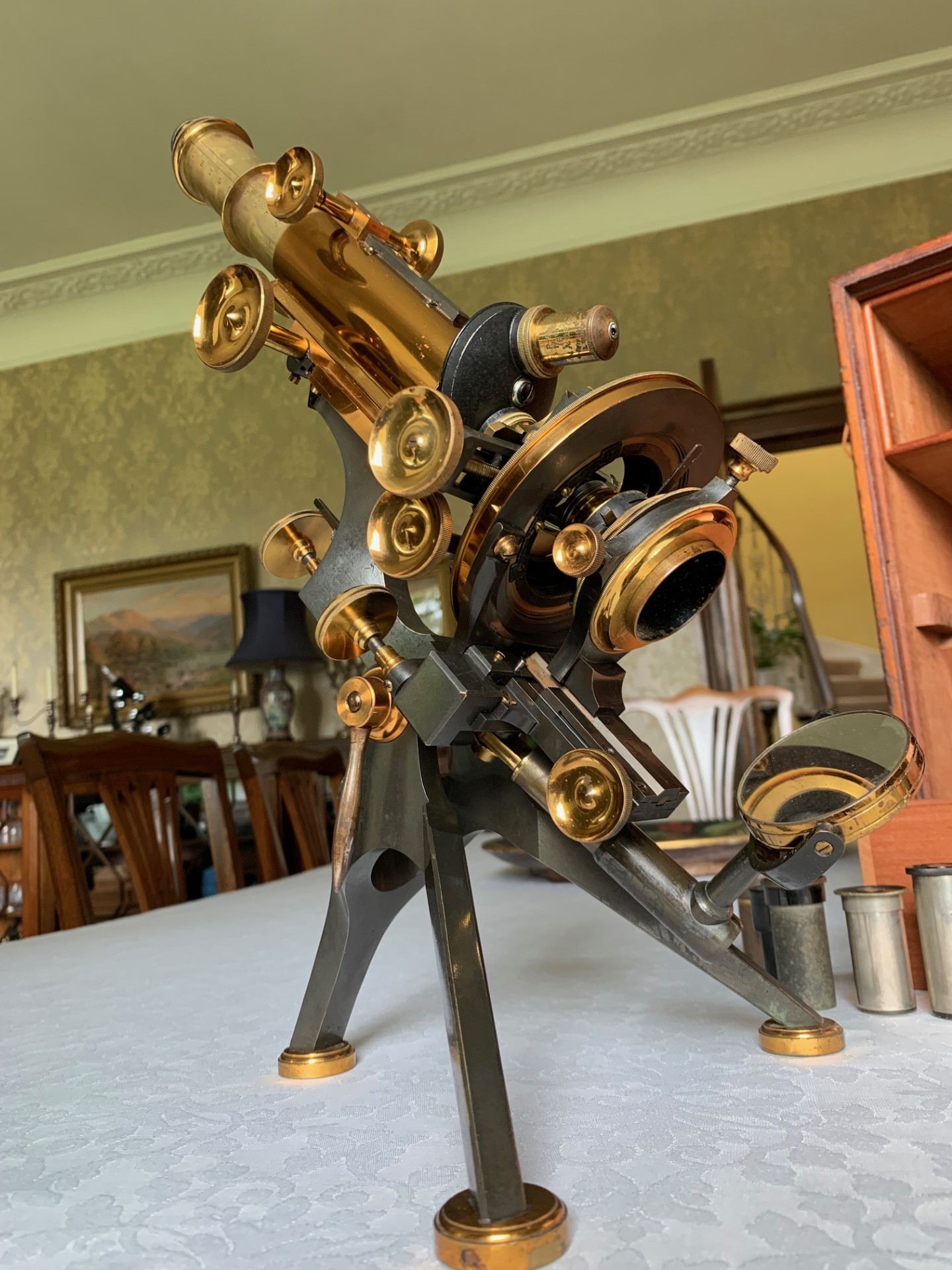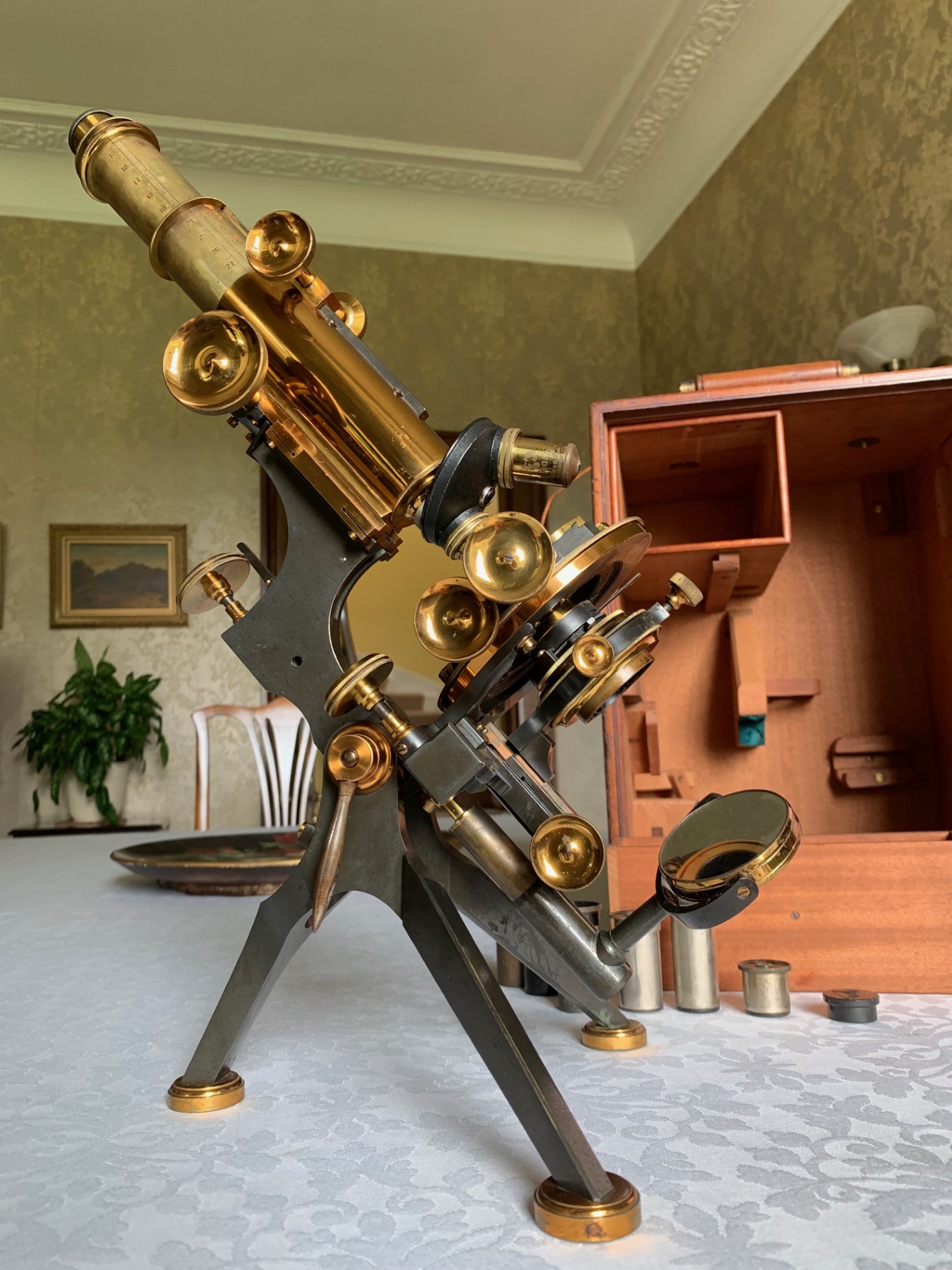SOLD – Antique W. Watson & Sons – Van Heurck No.1 Brass Microscope – circa 1901, Cased
Sold
Excellent condition Watson Van Heurck No. 1 dating to 1901, with lovely almost unmarked brass-work, its original fitted case and some nice accessories. Great example that's perfect for a scientific instrument collector and/or Watson connoisseur.
Circa
1901
Maker
W. Watson & Sons
Country of manufacture
UK and Ireland
Description
Offered for sale is a highly collectable example of Watson’s Van Heurck brass microscope and particularly special in that it’s in excellent condition and still has its original fitted case with recessed brass detailing. It’s quite an imposing instrument standing over 18 inches high when the draw-tubes and coarse focus are both racked out. This example dates to around 1901 based on its serial number 6430 which is engraved on the tripod just above the rear brass bun-foot and means that it’s quite an early No. 1 model.
The Van Heurck model range was produced by W. Watson & Sons Ltd based on a design scheme originally proposed by famous Belgian microscopist Henri Van Heurck (1839 – 1909), hence the designation afforded to this top-of-the range series of Watson instruments. The Van Heurck, Royal and Edinburgh models of Watson microscope all bear the same signature shape and indeed the Van Heurck was essentially based upon Watson’s Edinburgh design of microscopes, which they had been manufacturing in various guises since about 1887. The signature form includes a tripod base and Lister-type upper limb with vernier screw/lever fine focus mechanism. The Van Heurck models tend to have additional features over and above both Royal and Edinburgh models and also sometimes various bespoke options or accessories, because Watson offered customisation and quite a number of discerning customers must have had their instruments built to their own individual specifications. Van Heurck’s aims with specifying this model’s key features appears to have been to assist with his study of diatoms, especially with improvements such as sub-stage fine adjustment and fully mechanical rotating stages. There were a number of different Van Heurck models produced by Watson with quite a complicated series of enhancements and developments, together with a range of accessories. The Van Heurck variants produced by Watson from around 1893, with final examples produced into the 1930s, were as follows:
1893 to 1896 – Van Heurck Model A
1893 to 1900 – Van Heurck Model B – double draw-tube added
1896 to 1921* – Van Heurck Grand Model – concentric x/y controls and slightly larger tripod giving enhanced overall size
1900 to 1923* – Van Heurck No. 1 – similar to Model B – this example
1900 to 1923* – Van Heurck Circuit Stage – full 360 degree stage rotation
* final versions – production would have continued beyond these dates into the 1930s
This example #6430 dating to about 1901 therefore appears to be a No. 1 model and quite an early example with about 270 degrees of stage rotation, until the x/y adjustment thumb-wheels catch on the sub-stage fine adjustment thumb-wheel or upper limb – as demonstrated in the listing photos. I’m sure that the Watson cognoscenti will have their own views, but I believe that this example must be a No. 1 in view of the partial stage rotation. The spread of the front tripod legs measures 8 inches and they are also shod with cork pads, both features of the Van Heurck model.
Turning to the technical details of this instrument, the coarse focus is via rack and pinion with smooth action and tension adjustment available for the pinion gear. Fine focus is achieved via a separate brass thumb-wheel with graduation markings up/down rubric with indicator confirming that one full revolution of the fine adjustment thumb-wheel = 1/13th mm of travel (for the optical tube). It’s located at the rear of the upper limb and works by a vernier screw acting on an internal lever system. The focusing technique being to achieve near focus with the coarse thumb-wheels, then fine-tune with the single rear thumb-wheel.
With its optics, this Watson Van Heurck comes fitted with a period graduated brass eyepiece draw-tube inside another brass graduated draw-tube operated via a rack and pinion system all of which sits inside the main brass optical tube. Extending the draw-tubes increases the available magnification quite noticeably and you also have to re-focus. There’s a number of eyepieces supplied with the instrument as under – these are all 23mm diameter and fit into an adapter unit:
– 5x magnification – Periplan by Ernst Leitz Wetzlar
– No. 2 – 6x magnification – Watson
– No. 4 – 10x magnification – Watson
– 12.5x magnification – Carl Zeiss Jena
– 15x magnification wide-field by Otto Siebert
There’s a number of brass objective lenses (all RMS fit) and a double turret by Spencer Lens Co. which rotates freely with a nice positive feel as the objectives slot into their viewing position:
– 2 inch Watson parachromatic – 3x magnification
– 1/4 inch by Arnold & Sons – 20x magnification
– 1/6th inch by Swift – 40x magnification
– 1/6th inch Parachromatic by Watson – 40x magnification
– 1/12th inch by Swift – 100x magnification and requires oil immersion
Overall therefore, the range of magnification available with the draw-tubes set at standard length ranges from about 15x with the lowest power lens combination, up to around a theoretical 1,500x with the highest power combination and with the benefit of good illumination and of course oil immersion when using the high-power 1/12th inch objective.
The fully mechanical circular stage is very well engineered and a delight to use. It’s got twin thumb-wheel x/y adjusters on the right hand side of the stage with smooth positive action, vernier scales for both axes and a silvered 360 degree scale around the outer edge. It is currently fitted with a sliding specimen holder for holding slides steady during inclined viewing and when the axes are being moved around which works very well and can be removed for cleaning or locked in position when in use. It’s also got a lever for ejecting the slide, which is quite a neat feature that’s often over-looked. There’s also another plain brass top-plate with slide clips that can be used as an alternative and when not in use this top-plate has its own storage rack inside the case. The stage also rotates and will complete about 270 degrees of rotation – the action is well damped and holds position well on adjustment. The instrument also tilts for inclined viewing, holding in position as it should and can be tensioned as required via the lever on the right-hand side of the pivot.
Turning to the sub-stage, we have a Watson condenser body that’s supplied with two RMS top lenses as noted below:
– Swift aplanatic
– Swift dark ground in brass canister
The condenser assembly is top-mounted into a brass ring-carrier with centering controls comprising brass thumb-screws, which in turn sits in a height adjustable rack and pinion mount with additional vernier fine adjustment via a vertically mounted thumb-wheel located above and to the rear of the stage. There’s a single-sided brass thumb-wheel for coarse adjustment of the condenser height, which also has adequate reach for oiling to the back of slides as may be required for high magnification work. The condenser assembly has a working iris with graduation markings to control lighting levels, with smooth action. The condenser also has a swing-out filter carrier with various filters and stops provided. Lighting is via a brass mounted plano-concave mirror on a height and swing adjustable brass support arm and gimbal, with period silvering that’s in very good period condition to both sides.
The instrument and its controls have been very gently cleaned, lightly lubricated where necessary with non-hardening grease and operate smoothly with age-appropriate signs of wear to moving parts and friction surfaces. This instrument presents amazingly well with lovely gleaming brass-work showing very few signs of tarnishing or spotting, which is what you’d hope to see on an instrument of this age and quality that’s been very well looked after and probably treasured as an heir-loom throughout its life. Overall, it’s in very good to excellent shape for its age and I’m in two minds whether to retain this example for my own collection – I guess time will tell. This No. 1 Van Heurck is essentially a really nice collectible top-flight Watson in the right condition and it’ll make a great usable instrument and also a stunning display piece. It also presents rather well while being used as a desk-top instrument and will also look good in a library or home office setting, especially when set up with a suitable antique slide.
Accessories supplied with the instrument:
– set of dark-field stops in brass case
– blue filter
– frosted glass filter
– nicol prism analyser which attaches to the eyepiece draw-tube – for polarised light work
– nicol prism polariser which fits into the 39mm condenser ring carrier – for polarised light work
– alternative brass stage top-plate with slide clips
There’s also the correct original storage case with this example with internal fittings and two accessory drawers – note these have replacement brass handles that have been substituted for the original ivory handles. The case has a lovely external patina with retained period sheen. It’s also got great detailing and especially noteworthy are the recessed brass features to the door and dovetailed edges – this would have been an expensive option in its day, making this a premium-quality storage case.
Owing to the weight and delicacy of this antique microscope and case, it will be partially dismantled, very well wrapped for shipping and dispatched by insured courier upon receipt of cleared funds. Yes, it’s expensive, but it will be quite difficult to find another such example, especially of a rare Van Heurck with such a nice case along with the instrument in period condition that’s this good. So, if there’s a gap in your collection for a Van Heurck, or if a Van Heurck is something of a grail piece, as it was with me for a long time, then maybe you’ve finally found one.
Thanks for looking – please also check out my other listings if you get the chance.
Ask the Dealer
Dealer information
 Arcboutant Scientific
Arcboutant Scientific
Arcboutant Scientific based in Glasgow Scotland, with an interest in scientific collectables dating back to 1988. Now making available carefully curated fine examples, principally of antique microscopes and associated scientific equipment by quality English and Continental makers, to collectors world-wide.




